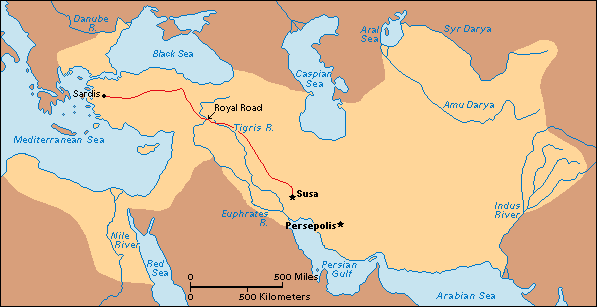|
|
|
 The
Royal Road
The
Royal Road

The Royal Road was built by the Persians after the fall of the Lydian Empire in 546 B.C. The road went from Sardis to Susa originally, but was modified over the centuries as trade centers shifted with the times. Sardis, in the 6th century B.C. was the capital of Greek lonia, while Susa was capital of the Persian Empire. Cyrus needed a quick and reliable route between Susa and his newly acquired territory, lonia. He had widened trails through forest, laid log roads across marshland and widened passes through mountains. Along this route, about 1600 miles in length, Cyrus had stationed over 100 rest stops and horse relays to aid his official messengers, very similar to the Pony Express in much later North America. The entire distance, Sardis-Susa, can be covered in seven grueling 24-hour days. The cost for the Royal Road in human labor, however, was incalculable.
According to Professor Girshman, Iranians in Achaemenid times had developed a method of road building that consisted of paving the softer parts of the road, and even of making artificial ruts for wheeled vehicles. The Greek historian, Herodotus, states that the Persian Royal Road anticipated the Roman road by several centuries.
The Greek historian, attributes the creation of post and couriers to the Achaemenid Persians. He states:" The entire plan is a Persian innovation." In order to facilitate communications within the vast Persian Empire, Post stations were built along all routes to provide rest stations for the caravans and fresh horses for couriers on government business. Post stations were precisely spaced at intervals equaling one day's ride connecting the royal road stretching 2000 miles. Strong, skilled men riding fast, muscular horses carried royal messages as far as 1600 miles in one week. Herodotus marveled, "Nothing mortal travels so fast as these messengers. They will not be hindered from accomplishing at their best speed the distance which they have to go, either by snow, or rain, or heat, or by the darkness of night" This system of communications was unmatched in speed until the telegraph doomed the horse to obsolescence.
If you have any questions or comments feel free to e-mail me.
Senior Project : 2001-2002 The Great Persian Empire Website